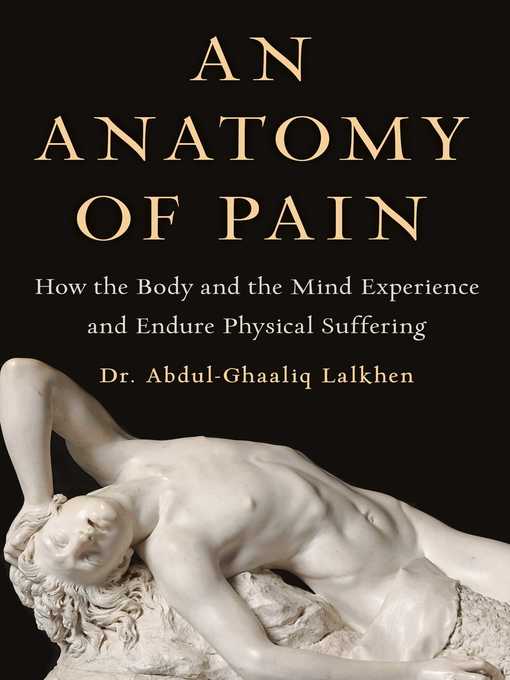
An Anatomy of Pain
How the Body and the Mind Experience and Endure Physical Suffering
چگونه بدن و ذهن تجربه و تحمل رنج فیزیکی
کتاب های مرتبط
- اطلاعات
- نقد و بررسی
- دیدگاه کاربران
نقد و بررسی

November 1, 2020
A physician who focuses on pain management illuminates his specialty. After a chapter describing the nervous system and another on the history of pain relief--opium has been around since prehistory--British anesthesiologist Lalkhen takes up pain as experienced by patients and dealt with by doctors. The author makes it clear that both could use further education on the subject, which is undeniably complex. A sprained ankle is agonizing while soldiers suffering gruesome battle injuries sometimes feel little pain. In Chinese and Korean cultures, it's often considered shameful to complain during childbirth, and few women receive analgesics; other cultures insist on "a more vocal response." While it may be understandable for a patient to not fully comprehend the social and psychological factors that influence pain as much as the physical damage, it's inexcusable for a doctor. New analgesic drugs have been appearing for more than two centuries, beginning with morphine in 1804. Although many surgeons remain casual about postoperative pain, the treatment of short-term pain remains straightforward. Chronic pain, however, is another story; sometimes it persists after the injury heals. In most cases of chronic back pain, neck pain, neuropathy, and even arthritis and in syndromes such as fibromyalgia, there is no injury and nothing to be "fixed"--but there are numerous ways to help. Sadly, many doctors continue to use procedures--e.g., surgery or nerve injections--that rarely work and prescribe drugs that produce side effects and addiction without relieving much pain. Lalkhen describes his multidisciplinary clinic, where doctors work with physiotherapists, nurses, psychologists, dieticians, and even alternative healers to help sufferers who often arrive addicted and desperate after undergoing repeated failed procedures. The author emphasizes that chronic pain is not curable, but a collaborative approach in which patients actively participate improves quality of life, self-confidence, and the ability to move, function, and return to work. Readers won't find miracles but rather a sensitive doctor who writes well about an ongoing epidemic.
COPYRIGHT(2020) Kirkus Reviews, ALL RIGHTS RESERVED.

November 30, 2020
Lalkhen, member of the Faculty of Pain Medicine at the Royal College of Anaesthetists in London, debuts with an accessible survey of pain, a sensation that “reduces us all to our basest elements.” Drawing on research and his own experiences as a physician, the author explains that pain is largely misunderstood by both the public and medical professionals, noting, for example, that “we don’t really understand why human beings suffer with pain in the joints as they get older,” since there are no nerves in joint cartilage. He charts shifting cultural attitudes toward pain, notably in the use of anesthetics during childbirth, describing how it was once “a violation of God’s law” to dull labor pain, as it was thought that a mother’s pain helped her bond with a child. Lalkhen makes clear how much of pain is subjective: any person’s experience of it depends on their “psychological makeup, genetics, gender, beliefs, expectations, motivations, and emotional context.” Along the way, Lalkhen traces his experience from simply managing patients’ pain to understanding that their psychological and social circumstances must be factored into treatment. With insights both scientific and personal, Lalkhen’s study sheds light on a mysterious corner of physiology and medicine. Agent: George Lucas, InkWell Management.

December 1, 2020
With rare exceptions, most humans experience pain. Lalkhen, an anesthesiologist and pain specialist, says that an understanding of the physical and psychological causes of pain and available therapies can help individuals better cope with their own pain and that of others. He first explains the physiological and chemical mechanisms that cause pain, then briefly traces how it was understood and addressed throughout history. Discussions of the pros and cons of current treatments lead to his conclusion that while the how and why of pain are now understood, the care of those suffering from chronic or unexplained pain is too limited. He sufficiently describes his own evolution in thinking and treatment choices, and outlines how a multidisciplinary, structured approach to those with chronic pain is used in his clinic, where standard therapies are combined with an emphasis on the psychological and social needs of patients, some of whom will need help their entire lives. VERDICT Clearly intended primarily for pain sufferers and those supporting them, the book provides appropriately detailed and understandable information while also offering suggestions practitioners should consider.--Richard Maxwell, Porter Adventist Hosp. Lib., Denver
Copyright 2020 Library Journal, LLC Used with permission.

December 1, 2020
In exploring and explaining the experience of pain, anesthesiologist Lalkhen recognizes pain as ""a great equalizer and unifier."" It's an intricate alarm system alerting us that something is harmful or wrong. It's a physical (sensory) and emotional experience influenced by many factors, such as expectations, mood, genetics, and culture. Despite medical technology, pain still cannot be accurately quantified. The neurobiology and mechanics of pain, its psychology, the human history of comprehending and extinguishing pain, modalities to manage it, and opioid addiction are reviewed. Treatments including acetaminophen, narcotics, epidurals, and implantable spinal cord stimulators are discussed. Lalkhen cautions that many commonly prescribed pain medicines ""are flawed and dangerous."" He advocates lifestyle modifications (exercise, weight loss), physical therapy, meditation, and cognitive behavioral therapy as useful treatments for pain. Fascinating facts are incorporated, including how, at one time, Sears and Roebuck sold morphine (with a syringe) for $1.50 in their catalog. Lalkhen identifies the sense of helplessness both patients suffering from pain and the doctors who treat them may feel. He understands that ""[t]he pain of a broken heart is therefore no less distressing than that of a broken leg."" At some point in our life, we all hurt. This splendid book--informative, empathic, and wise--about a universal experience will surely promote healing.
COPYRIGHT(2020) Booklist, ALL RIGHTS RESERVED.

























دیدگاه کاربران